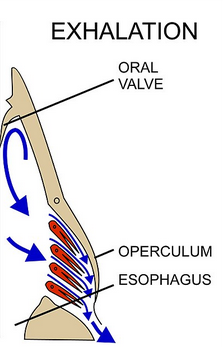
Rate of breathing is controlled by ?
Answer
442.8k+ views
Hint: Breathing is an important mechanism being carried out in the human and other animal bodies. It is the process in which we intake or inhale air which is oxygen into lungs and expel carbon-dioxide from the body. Now, breathing rates can be determined by factors; one such factor is present in brain medulla oblongata which controls the rate of breathing. As, human brain holds the commands of all the major activities taking place in the body, breathing rates are one of them.
Complete answer:
The primary respiratory control center is medulla oblongata. Its main function is to send signals to the muscles that control respiration to cause breathing to occur. There are two regions in the medulla that control respiration. The ventral respiratory group stimulates expiratory movements.
As we already knew about which part of our brain controls the rate of breathing. Now let us know about ventilation. Ventilation is nothing but the physiological mechanisms being carried out or involved in breathing. It facilitates breathing. As we know, respiration’s most important function is the supplying of oxygen to the body and balancing the carbon dioxide levels in the body. The chemical receptors which detect the changes in the levels of oxygen and carbon dioxide are located in the arterial aortic bodies and carotid bodies. Central chemoreceptors are located on the medulla oblongata near the medullary respiratory groups.
There are four respiratory groups two in the medulla and two in the pons, the two groups in the pons are known as pontine respiratory groups.


From the respiratory center, the air in and from the lungs is activated by the muscles of respiration, especially by the diaphragm.
Note:
Breathing is normally an unconscious, involuntary automatic process. Motor stimuli can be divided into an inhalation and exhalation stage during breathing. Inhalation is the ramping increase in motor discharge and the exhalation is usually silent, except at high respiratory rates.
Complete answer:
The primary respiratory control center is medulla oblongata. Its main function is to send signals to the muscles that control respiration to cause breathing to occur. There are two regions in the medulla that control respiration. The ventral respiratory group stimulates expiratory movements.
As we already knew about which part of our brain controls the rate of breathing. Now let us know about ventilation. Ventilation is nothing but the physiological mechanisms being carried out or involved in breathing. It facilitates breathing. As we know, respiration’s most important function is the supplying of oxygen to the body and balancing the carbon dioxide levels in the body. The chemical receptors which detect the changes in the levels of oxygen and carbon dioxide are located in the arterial aortic bodies and carotid bodies. Central chemoreceptors are located on the medulla oblongata near the medullary respiratory groups.
There are four respiratory groups two in the medulla and two in the pons, the two groups in the pons are known as pontine respiratory groups.


From the respiratory center, the air in and from the lungs is activated by the muscles of respiration, especially by the diaphragm.
Note:
Breathing is normally an unconscious, involuntary automatic process. Motor stimuli can be divided into an inhalation and exhalation stage during breathing. Inhalation is the ramping increase in motor discharge and the exhalation is usually silent, except at high respiratory rates.
Recently Updated Pages
Master Class 11 Business Studies: Engaging Questions & Answers for Success

Master Class 11 Economics: Engaging Questions & Answers for Success

Master Class 11 Accountancy: Engaging Questions & Answers for Success

Master Class 11 Computer Science: Engaging Questions & Answers for Success

Master Class 11 English: Engaging Questions & Answers for Success

Master Class 11 Maths: Engaging Questions & Answers for Success

Trending doubts
The flightless birds Rhea Kiwi and Emu respectively class 11 biology CBSE

1 litre is equivalent to A 1000mL B 100cm3 C 10mL D class 11 physics CBSE

A car travels 100 km at a speed of 60 kmh and returns class 11 physics CBSE

Name the Largest and the Smallest Cell in the Human Body ?

Explain zero factorial class 11 maths CBSE

In tea plantations and hedge making gardeners trim class 11 biology CBSE




